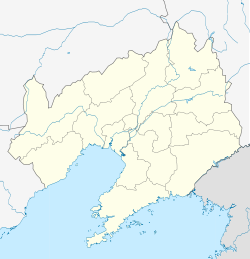Jianchang County
Jianchang
建昌县 Chienchang | |
|---|---|
 Location in Huludao City | |
| Coordinates: 40°49′N 119°50′E / 40.817°N 119.833°E | |
| Country | People's Republic of China |
| Province | Liaoning |
| Prefecture-level city | Huludao |
| County seat | Jianchang Town (建昌镇) |
| Area | |
• Total | 3,195 km2 (1,234 sq mi) |
| Elevation | 369 m (1,211 ft) |
| Population (2020 census[1]) | |
• Total | 453,436 |
| • Density | 140/km2 (370/sq mi) |
| Time zone | UTC+8 (China Standard) |
| Postal code | 125300 |
Jianchang (Chinese: 建昌; pinyin: Jiànchāng) is a county of Huludao City in the southwest of Liaoning province, China. It is the largest division of Huludao, with an area of 3,195 square kilometres (1,234 sq mi),[2] and population of 450,000 in 2020, located in mountainous terrain 85 kilometres (53 mi) west of that city, serviced by China National Highway 306. The Weizhangzi–Tashan railway also passes through the County.[3]
Near the border with Hebei province lies the Jianchang Longtan Grand Canyon, home to wide variety of plants and animals. In 2009 a Troodontid dinosaur fossil with feathers was discovered in Jianchang. It is the earliest known such fossil and provides evidence for the link between dinosaurs and birds.[4] Also found here, in Jiufotang Formation rocks, was the early modern bird Schizooura.[5]
Administrative divisions
[edit]There are seven towns, 21 townships, and one ethnic township in the county.[6]
Towns:
- Jianchang (建昌镇)
- Bajiazi (八家子镇)
- Lamadong (喇嘛洞镇)
- Yaowangmiao (药王庙镇)
- Tangshenmiao (汤神庙镇)
- Linglongta (玲珑塔镇)
- Datun (大屯镇)
Townships:
|
|
|
Climate
[edit]| Climate data for Jianchang, elevation 367 m (1,204 ft), (1991–2020 normals, extremes 1981–2010) | |||||||||||||
|---|---|---|---|---|---|---|---|---|---|---|---|---|---|
| Month | Jan | Feb | Mar | Apr | May | Jun | Jul | Aug | Sep | Oct | Nov | Dec | Year |
| Record high °C (°F) | 12.6 (54.7) |
19.1 (66.4) |
28.5 (83.3) |
32.3 (90.1) |
38.2 (100.8) |
38.4 (101.1) |
40.7 (105.3) |
37.3 (99.1) |
34.9 (94.8) |
31.1 (88.0) |
21.4 (70.5) |
18.3 (64.9) |
40.7 (105.3) |
| Mean daily maximum °C (°F) | −1.4 (29.5) |
2.7 (36.9) |
9.6 (49.3) |
17.9 (64.2) |
24.5 (76.1) |
27.8 (82.0) |
29.1 (84.4) |
28.4 (83.1) |
24.5 (76.1) |
17.1 (62.8) |
7.2 (45.0) |
0.2 (32.4) |
15.6 (60.2) |
| Daily mean °C (°F) | −8.6 (16.5) |
−4.5 (23.9) |
2.8 (37.0) |
11.4 (52.5) |
18.0 (64.4) |
21.7 (71.1) |
23.9 (75.0) |
22.7 (72.9) |
17.5 (63.5) |
9.9 (49.8) |
0.7 (33.3) |
−6.4 (20.5) |
9.1 (48.4) |
| Mean daily minimum °C (°F) | −14.0 (6.8) |
−10.3 (13.5) |
−3.3 (26.1) |
4.8 (40.6) |
11.4 (52.5) |
16.1 (61.0) |
19.3 (66.7) |
17.9 (64.2) |
11.5 (52.7) |
3.8 (38.8) |
−4.4 (24.1) |
−11.4 (11.5) |
3.5 (38.2) |
| Record low °C (°F) | −28.3 (−18.9) |
−24.3 (−11.7) |
−19.7 (−3.5) |
−6.9 (19.6) |
1.5 (34.7) |
6.7 (44.1) |
11.8 (53.2) |
7.5 (45.5) |
−0.2 (31.6) |
−8.2 (17.2) |
−19.5 (−3.1) |
−24.9 (−12.8) |
−28.3 (−18.9) |
| Average precipitation mm (inches) | 1.9 (0.07) |
2.7 (0.11) |
6.4 (0.25) |
24.0 (0.94) |
47.9 (1.89) |
100.8 (3.97) |
160.3 (6.31) |
122.5 (4.82) |
44.7 (1.76) |
25.9 (1.02) |
10.4 (0.41) |
1.6 (0.06) |
549.1 (21.61) |
| Average precipitation days (≥ 0.1 mm) | 1.6 | 1.5 | 2.8 | 5.0 | 7.4 | 11.7 | 12.0 | 9.1 | 6.7 | 4.8 | 2.9 | 1.6 | 67.1 |
| Average snowy days | 2.6 | 2.1 | 2.9 | 1.3 | 0.1 | 0 | 0 | 0 | 0 | 0.6 | 3.1 | 2.7 | 15.4 |
| Average relative humidity (%) | 48 | 43 | 39 | 41 | 47 | 64 | 76 | 76 | 68 | 57 | 53 | 51 | 55 |
| Mean monthly sunshine hours | 196.1 | 195.2 | 234.3 | 244.0 | 266.7 | 231.7 | 213.0 | 229.4 | 233.7 | 223.9 | 185.4 | 184.2 | 2,637.6 |
| Percent possible sunshine | 66 | 64 | 63 | 61 | 59 | 52 | 47 | 54 | 63 | 66 | 63 | 64 | 60 |
| Source: China Meteorological Administration[7][8] | |||||||||||||
References
[edit]- ^ "China: Liáoníng (Prefectures, Cities, Districts and Counties) – Population Statistics, Charts and Map".
- ^ "Huludao Administrative Districts". Huludao Municipal Government. Archived from the original on 2009-10-05. Retrieved 2010-01-08.
- ^ "建昌县" [Jianchang County]. hldnews.com (in Chinese). Retrieved 9 March 2021.
- ^ China's new dinosaur fossil sheds light on bird origin, 2009/09/25
- ^ Shuang Zhou, Zhong-He Zhou and Jingmai K. O’Connor (2012). "A new basal beaked ornithurine bird from the Lower Cretaceous of Western Liaoning, China" (PDF). Vertebrata PalAsiatica. 50 (1): 9–24.
- ^ 2011年统计用区划代码和城乡划分代码:建昌县 (in Chinese). National Bureau of Statistics of the People's Republic of China. Archived from the original on November 28, 2012. Retrieved 2012-07-17.
- ^ 中国气象数据网 – WeatherBk Data (in Simplified Chinese). China Meteorological Administration. Retrieved 29 July 2023.
- ^ 中国气象数据网 (in Simplified Chinese). China Meteorological Administration. Retrieved 29 July 2023.

